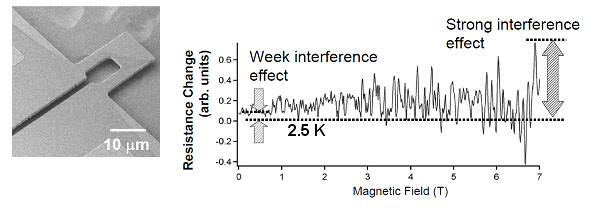Hiroshi Yamaguchi and Yoshiro Hirayama
Physical Science Laboratory
Å@Ultra-small force and displacement have been detected using
a small bar, clamped at one end like a diving board, known as a cantilever.
It is already used in practical systems, such as in the pickups for analog
disks, atomic force microscopes, and the accelerometers of automobile airbag
systems. Especially, the micron-scale cantilevers play essential roles in
the technology using microelectromechanical systems (MEMS), which has made
rapid advances in the last few years. For detecting the cantilever deflection,
both optical and electrical methods are widely used. Optical methods, such
as optical levers and laser interferometers, offer higher detection sensitivity
than electrical ones. They have been recently used even for the detection
of single spins [1]. In contrast, electrical methods are advantageous for
downscaling and integration. In addition, we could strongly enhance the detection
sensitivity in piezoresistive cantilevers, which is one of the most important
electrical methods, using the quantum effects in semiconductor low-dimensional
structures.
Å@At low temperatures, electrons exhibit wave-like behavior, so they can be
used for highly accurate sensing just like the photons in a laser interferometer.
We have succeeded in detecting the displacement of a micromechanical cantilever
by using electron interference [2]. The device used was an InAs/AlGaSb pieozoresistive
cantilever with the thicknesses of conductive InAs and insulating AlGaSb films
of 15 nm and 285 nm, respectively. A scanning electron microscope image of
a typical fabricated device is shown in Fig. 1. The resistance change induced
by the cantilever deflection was measured under a magnetic field (Fig.2).
The magnetic field was used to adjust the phase differences among different
electron paths in the InAs films. The resistance change, i.e. the cantilever
deflection sensitivity, has a strong and aperiodic B dependence,
which was reproducible in repeated measurements. At 6.9 T, the resistence
change had a maximum value, which was nearly one order of magnitude larger
than that at zero magnetic field. This clearly demonstrates the possibility
of highly sensitive quantum mechanical displacement sensing, which is promising
for future micromechanical cantielver applications.
[1] D. Ruger et al., Nature 430 (2004) 329.
[2] H. Yamaguchi et al, Phys. Rev. Lett. 93 (2004) 036603.
 |
||
|
Fig. 1 SEM image of a
fabricated piezoresistive cantilever. |
Fig. 2 Measured resistance change as
a function of magnetic field. |
|